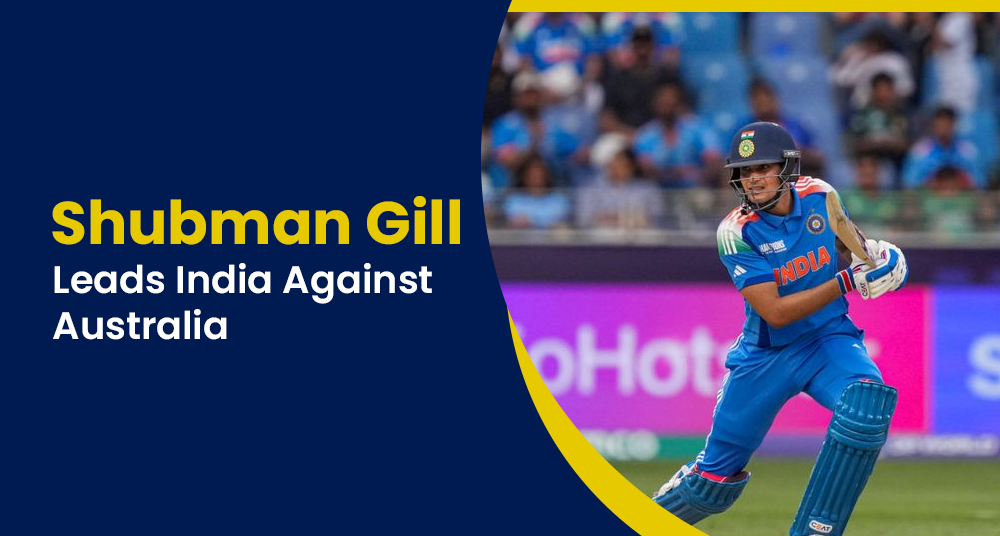A major shakeup has rocked Indian cricket: for the upcoming ODI series in Australia, Shubman Gill has been appointed captain of India’s One Day side, replacing Rohit Sharma. The decision marks not only a leadership change but also signals a clear forward-looking strategy by the BCCI and selectors. In this article, we explore the India’s Squad for Australia, context, reasoning, squad composition, challenges, expectations, reactions, and implications of this bold move.
The Announcement & Context
On 4 October 2025, the Indian selectors officially confirmed that Shubman Gill would lead India in ODIs for the three-match series starting 19 October in Australia.
Rohit Sharma and Virat Kohli, though no longer captains in other formats, have been retained in the ODI squad.
The selectors and BCCI justified the change by pointing out the challenge of maintaining three different captains for three formats, the long horizon towards the 2027 World Cup, and the desire to groom a consistent, younger leader.
Chief selector Ajit Agarkar reportedly emphasized that with fewer ODIs in the calendar, giving the new captain enough time in the role is crucial.
Gill’s elevation also builds on his recent performances in Test leadership and batting form — he already captains India in Tests and is vice-captain in T20Is.
In short: the change is less of a sudden snatch, and more of a planned generational transition.
Why This Decision? Rationale & Strategic Thinking
Consolidation of Leadership Across Formats
One of the recurring challenges in modern Indian cricket has been multiple captains across formats (Test, ODI, T20). The selectors want more coherence in team culture, strategy, and leadership continuity. Having Gill command ODIs aligns better with his Test role and T20 vice-captaincy.
Focus on the 2027 World Cup & Long Term Planning
Though 2027 is still two years away, the BCCI and selection committee want to give Gill enough runway in the role rather than making last-minute changes. With relatively fewer ODIs in the upcoming years, any leadership change needs time to settle.
Leverage Recent Test Leadership & Form
Gill’s recent successes as Test captain — especially his prolific run-scoring in England where he scored 754 runs in the series — gives confidence that he can manage strategy, temperament, and pressure.
Also, his batting consistency and youth make him a viable long-term leader.
Balanced Transition Retaining Experience
By keeping Rohit and Kohli in the ODI squad, the selectors aim to blend experience and fresh leadership, allowing for mentorship and continuity. This avoids a harsh cut-off and provides buffers in transition phases.
Modernizing for a Changing Format Landscape
ODIs are now played less frequently relative to T20s and Tests. That means every ODI match has more weight. The selectors may believe a younger, more dynamic captain can adapt better to evolving demands.
India’s Squad for the Australia Tour
Schedule & Format
India will tour Australia from 19 October to 8 November 2025 in a white-ball only tour: 3 ODIs followed by 5 T20 Internationals.
In ODIs, Gill will lead; in T20Is, Suryakumar Yadav has been named captain, with Gill as his vice.
ODI Squad Composition
Here is India’s 15-member ODI squad for the Australia series:
- Shubman Gill (c)
- Rohit Sharma
- Virat Kohli
- Shreyas Iyer (vice-captain)
- KL Rahul (keeper)
- Axar Patel
- Kuldeep Yadav
- Mohammed Siraj
- Arshdeep Singh
- Harshit Rana
- Prasidh Krishna
- Washington Sundar
- Dhruv Jurel (wk)
- Yashasvi Jaiswal
- Nitish Kumar Reddy
Notably absent are Ravindra Jadeja and Varun Chakaravarthy from the ODI squad (though Chakaravarthy is included in T20s). Jasprit Bumrah is rested for the ODI leg (but expected back for T20s).
T20I Squad Overview
In T20s, the squad includes:
- Suryakumar Yadav (c)
- Gill as vice-captain
- Abhishek Sharma, Tilak Varma, Nitish Kumar Reddy, Shivam Dube, Axar Patel, Jitesh Sharma, Varun Chakaravarthy, Jasprit Bumrah, Arshdeep Singh, Kuldeep Yadav, Harshit Rana, Sanju Samson, Rinku Singh, Washington Sundar
Key Storylines & Talking Points
The Rohit Era Comes to an End (in ODIs)
Rohit Sharma has served Indian cricket with distinction — a key contributor in white-ball formats and captain in ICC events.
But the decision to remove him as ODI skipper is symbolic — acknowledging that for long-term stability and succession planning, a younger leader must begin to take charge. Many among fans, analysts, and former players were surprised.
Balancing Experience & Youth
Retaining veteran batsmen like Rohit and Kohli provides depth, stability, and mentorship. The blend is meant to ensure the team doesn’t lose composure under pressure, even as new leadership tests itself.
Bowling Dynamics & Selection Choices
- The omission of Ravindra Jadeja from the ODI squad raised eyebrows — selectors fielded Axar Patel over him citing balance and fitness concerns.
- Mohammed Siraj returns to ODI duties, especially with Bumrah resting. This offers India experience in pace attack during Australian conditions.
Vice-Captaincy: Role of Shreyas Iyer
Shreyas Iyer has been named vice-captain. His role next to Gill will be crucial in on-field decision-making and helping manage the transition.
The Australia Challenge
Australia is a demanding touring ground, especially for white-ball cricket — pace, bounce, fielding standards, and tough opponents. Gill’s first ODI captaincy test comes under high expectations.
Plus, the Australian series will test leadership choices, team balance, and execution under pressure.
Messaging to Future & ICC Tournaments
This captaincy switch hints that selectors are eyeing 2027 and want to build a captain who can carry the team through multiple cycles. The move tells fans and rivals India means business about continuity and renewal.
Expectations, Risks & Performance Metrics
Expectations from Gill & Team
- Strong starts in all three ODIs, ideally winning at least 2 to build confidence
- Tactical acumen: making smart bowling changes, field settings, and match management
- Handling pressure — e.g. chasing targets, close finishes
- Leadership on and off the field — inspiring consistent performance
- Managing senior players like Rohit, Kohli — ensuring team harmony
Risks & Pitfalls
- Overburdening a young captain in challenging touring conditions
- Senior players potentially reacting to being demoted or eased out
- Performance pressure: a few failures may be magnified under scrutiny
- Injury or workload management — as Gill has to juggle captaincy and batting
- Managing balance — in Australia, pace and adaptation matter heavily
Metrics to Watch
- Win/Loss record under Gill’s captaincy
- Batting averages of captain and key batsmen
- Bowling efficiency in Aussie conditions (bowling strike rate, economy)
- Fielding and catching performance (often underrated in leadership)
- Communication, strategy shifts mid-match
Feedback & Reaction in Media & Fans
- Former players and pundits expressed surprise, some criticism — e.g. Mohammad Kaif questioned whether Rohit was given enough time.
- Many fans see this as a natural “passing of the torch,” aligning with India’s trajectory of promoting younger leadership.
- Social media has reacted strongly — some nostalgic posts for Rohit, some excitement for Gill’s next chapter.
- Analysts are debating whether this is too soon or overdue; whether Gill will manage dynamics with senior players.
- Some in the press point to a 13-year-old post by Rohit resurfacing as symbolic.
What This Means for Indian Cricket
A Signal for Generational Shift
In many ways, this is emblematic: India is transitioning from an era defined by Rohit, Kohli, and their cohort, into the leadership of Jack-of-all-formats like Gill, backed by a younger support cast.
More Leadership Stability
If Gill holds his ground, this change could reduce captaincy volatility, giving longer tenures and clarity.
Impact on Player Careers
Senior names will now play more defined supporting roles. Some may fade out gradually, others adapt to specialist positions. The selectors signaling merit-based selection henceforth is likely.
Template for Future Tours
This could become the blueprint — fewer sways, early decisions, and leadership harmony across formats.
Conclusion
The decision to appoint Shubman Gill as ODI captain for India’s Australia tour is more than a format switch: it is a statement of intent, a strategy for continuity, and a calculated risk. While Gill steps into the role with promise and momentum, his leadership will be tested on the roads of Australia, under lights, pace, bounce, and expectations.
For fans, pundits, and players alike, this series is not just about wins or losses — it’s about legacy, transition, and vision. Will Gill prove he’s ready? Can the balance of youth and experience cohere into consistent performance? Only time (and the upcoming ODIs) will tell.
Related Blog: KL Rahul Cricket Career






What do you think?
It is nice to know your opinion. Leave a comment.